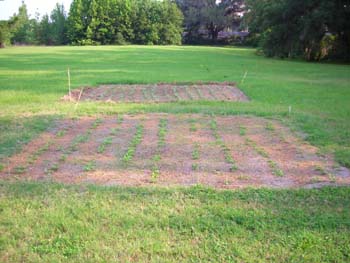Energy Garden Project
By: Gabriel Espinosa

The promise of many biofuels stems from their renewable nature and seeming ease of production. Often the rigors of agriculture, and by extension biofuel production, are lost upon those that have never gardened or farmed. To truly understand what producing bioenergy entails, one must see the process from the soil to the fuel tank. It was with this purpose that energy crops were planted in a garden to give us a better understanding of what goes into the production of bioenergy.

 The sunflower patch preparation began June 4th and took a week, most likely because of increased familiarity with the process. The topsoil was enriched with composted chicken manure and cow manure, again to increase yield. The chicken manure was used to add even more nitrogen to the soil since sunflowers don’t fix nitrogen like peanuts. The sunflower patch measures 18 feet per side giving it an area of 324 square feet. The sunflowers needed weeding only initially because they soon were taller than the surrounding grass, which gave them a competitive edge. The peanuts, however, needed to be weeded a few times before they could out-compete the surrounding weeds.
The sunflower patch preparation began June 4th and took a week, most likely because of increased familiarity with the process. The topsoil was enriched with composted chicken manure and cow manure, again to increase yield. The chicken manure was used to add even more nitrogen to the soil since sunflowers don’t fix nitrogen like peanuts. The sunflower patch measures 18 feet per side giving it an area of 324 square feet. The sunflowers needed weeding only initially because they soon were taller than the surrounding grass, which gave them a competitive edge. The peanuts, however, needed to be weeded a few times before they could out-compete the surrounding weeds.
 This activity has highlighted that there is much work needed in producing oil feedstocks for biodiesel. Taken together, the combined 549 square foot area will hopefully yield a gallon of vegetable oil to make biodiesel.
This activity has highlighted that there is much work needed in producing oil feedstocks for biodiesel. Taken together, the combined 549 square foot area will hopefully yield a gallon of vegetable oil to make biodiesel.
Energy Garden Video